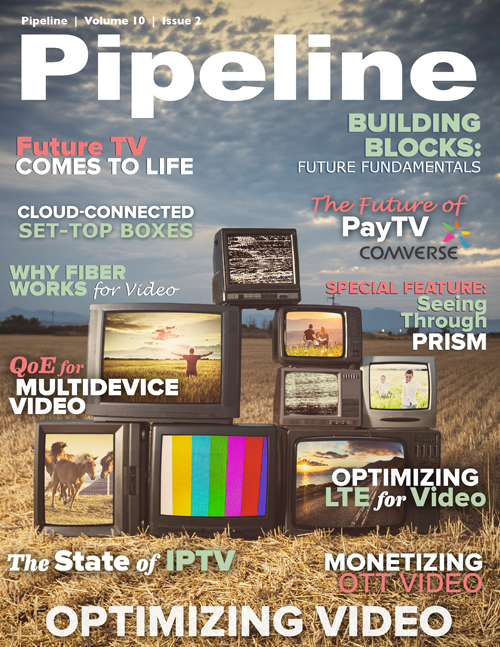Video Delivery: Why Fiber Works
With Google Fiberâs TV offering, viewers get a truly on-demand, âTV Everywhereâ experience. Combine that with its recently released TV app for the iPad and youâve got one superfast, supercool service ready to wow your next Super Bowl party.
In May, Bernstein Research published the results of a survey of 204 households in the Kansas City metro area and reported that 160, or approximately three-quarters, of the respondents had
contemplated subscribing to Google Fiberâs internet and/or TV services, while nearly three-quarters of that groupâ61 percent of the total number of householdsâindicated that itâs highly likely
they will sign up.
"These very high purchase-intent numbers do not allow us to rule out the possibility that Google will indeed achieve very high penetration of homes passed,â wrote Bernstein analyst Carlos Kirjner, âwell in excess of the typical 20 percent to 30 percent that [cable] over-builders have achieved historically in their most successful markets.â
It adds that while Google Fiberâs TV service isnât likely to be a big moneymaker for Google itself, it works as a value-added service that can entice potential subscribers. According to CNET reporter Marguerite Reardon, he hopes to turn a buck with the fiber loverâs paradise. âWe expect to make money from Google Fiber,â Medin said in his keynote address. âThis is a great business to be in.â
Whatâs most off-putting to the fiberphobics out there is the cost of deploying and maintaining a fiber-optic network. But as Pipeline reported last September, the cost is shrinking, and when one considers the future-proof capacity that fiber offers to new and old services alike, it barely even registers.
Even the bandwidth-hungriest hog on the block, Netflix places Google Fiber at the top of its current ISP Speed Index for the United States. The list suggests that Google Fiberâs ultrafast speeds have forced fixed-line providers like Cablevision, the runner-up, and Cox Communications, which is ranked third, to speed up their services if theyâre going to compete. Verizon FiOS, once the king of bandwidth, is at number six on the ISP Speed Index, behind Suddenlink and Charter Communications, respectively.
But speed isnât the sole differentiator when it comes to fiber video delivery, which is why Verizon recently announced the rollout of FiOS TV Home Page for its set-top boxes (STBs), one video hub office (VHO) at a time. When subscribers turn on their TVs theyâre shown a 15-second display of weather, video-on-demand (VOD) updates and other information tailored to their individual viewing habitsâplus a few ads, of course, to support the new service.
So, aside from the cost of creating a fiber-optic network that can reach every subscriberâs home, will the investment by service providers bear fruit like Googleâs Milo Medin thinks it will?
âIn the long term the investment in fiber will be worth it, especially with Ultra HD looming on the horizon,â says Jeff Heynen, principal analyst for broadband access and pay TV at Infonetics Research said. âThose operators with fiber will be able to more quickly integrate those levels of picture quality without having to do as much compression on the feed because of limited bandwidth.â
Picture quality isnât the whole game, however.
âThe fact is that we are already seeing tremendous growth in the number of simultaneous channels being watched, which puts tremendous strain on overall bandwidth,â Heynen adds. âIf you think about multiple STBs in the home, each recording multiple programs, as well as Wi-Fi delivery of video to tablets, bandwidth can get squeezed very quickly. With fiber, bandwidth contention becomes less of an issue.â
However, Multimedia Research Group (MRG) analyst Michelle Abraham sees fiber as more of a mixed bag. She points out that although Google Fiberâs TV model seems expensive at the outset, from the standpoint of operational efficiency itâs a real cost-cutter to run internet and TV services on the same network. But with constant strides being made to get more and more bandwidth out of copper via VDSL2 bonding and vectoring technologies, a service provider âmight look at the network and ask, âHow old is it?â âWhere am I having problems?ââ Abraham says. âAs copper technologies continue to evolve, some operators might look at a hybrid approach.â
Thereâs no denying it: people want their MTVânot to mention their ESPN, their CNN and so on, and they want it anytime, anywhere. Fiberâs big, beautiful superhighway of bandwidth will remain the gold standard for fast and furious data transport, so if you want to bask in the glory of the full Google experience, youâll either have to pack your bags for Kansas City or wait until Google Fiber comes to a fiberhood near you.



















